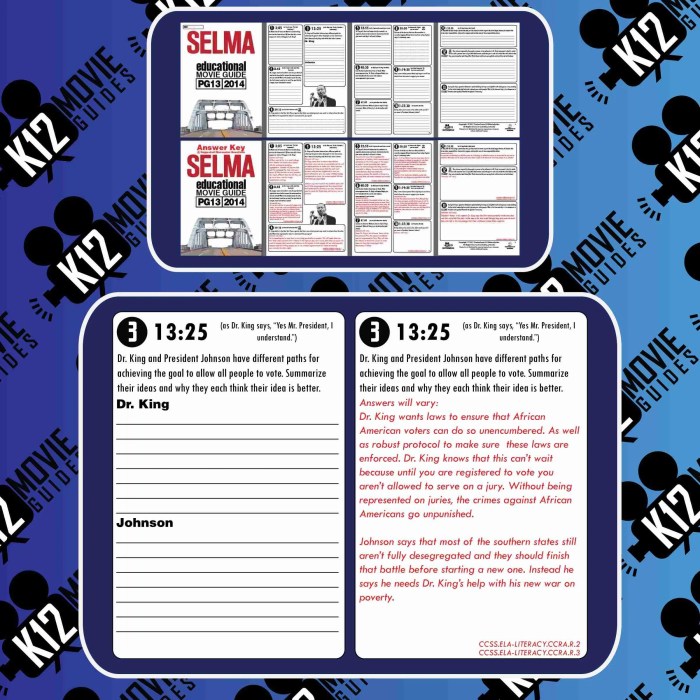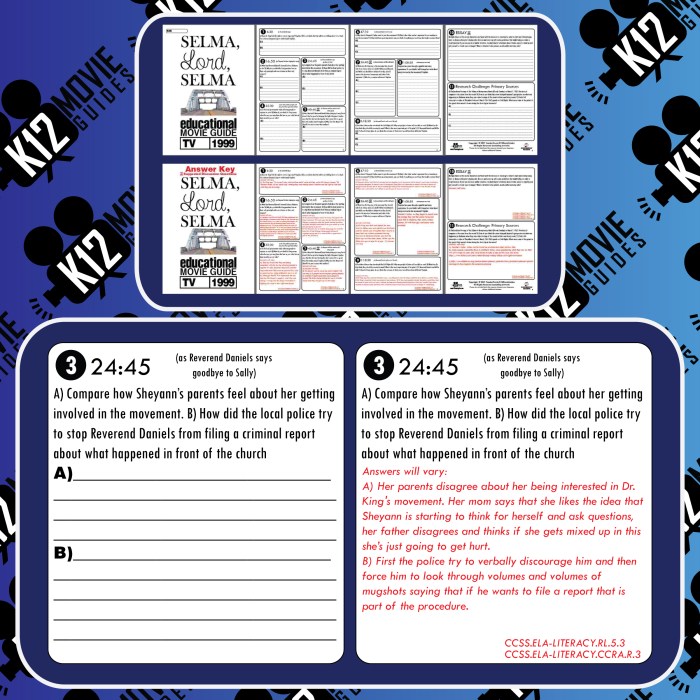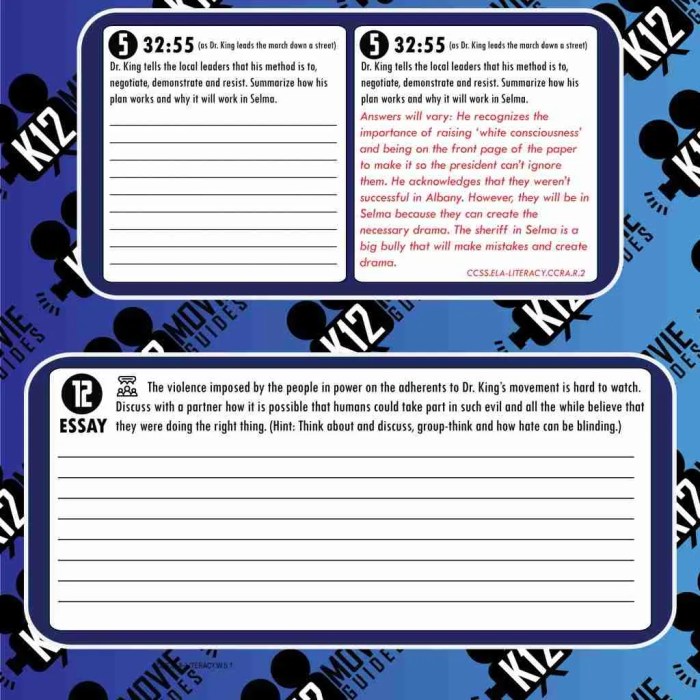Unveiling the selma movie questions answer key, this comprehensive guide delves into the historical significance, cinematic artistry, and social impact of the acclaimed film Selma. By examining key events, characters, and themes, this analysis provides a deeper understanding of the movie’s portrayal of the pivotal Selma to Montgomery marches and its lasting influence on the fight for civil rights.
Through an in-depth exploration of Selma’s cinematography, character development, and symbolism, this guide uncovers the film’s artistic merits and its ability to convey powerful messages about race, equality, and the indomitable spirit of those who fought for justice.
Historical Context: Selma Movie Questions Answer Key
The movie Selma is set against the backdrop of the historic events surrounding the Selma to Montgomery marches, a pivotal moment in the Civil Rights Movement in the United States.
The Selma to Montgomery Marches
In 1965, a group of civil rights activists, led by Dr. Martin Luther King Jr., organized a series of marches from Selma, Alabama, to Montgomery, the state capital, to protest the denial of voting rights to African Americans.
Dr. Martin Luther King Jr.’s Role
Dr. Martin Luther King Jr. played a central role in the Selma movement. As the leader of the Southern Christian Leadership Conference (SCLC), he advocated for nonviolent resistance and helped to organize the marches.
Plot Summary

Selma follows the events of the Selma to Montgomery marches, focusing on the key figures involved and the challenges they faced.
Main Events
- The movie depicts the planning and execution of the marches, including the violent confrontation with state troopers at the Edmund Pettus Bridge.
- It also shows the efforts of civil rights activists to overcome legal obstacles and secure voting rights for African Americans.
Key Characters
- Dr. Martin Luther King Jr. (David Oyelowo): The leader of the Selma movement.
- Annie Lee Cooper (Oprah Winfrey): A civil rights activist who is brutally beaten by state troopers.
- John Lewis (Stephan James): A young civil rights leader who plays a key role in organizing the marches.
- George Wallace (Tim Roth): The segregationist governor of Alabama who opposes the marches.
Cinematography and Visual Style

Selma’s cinematography is characterized by its use of natural light, handheld cameras, and a documentary-like aesthetic.
Lighting
The film’s use of natural light creates a sense of realism and immediacy. The scenes are often shot outdoors, with the sunlight providing the primary illumination.
Camera Angles, Selma movie questions answer key
The handheld cameras create a sense of intimacy and movement. The camera often follows the characters closely, capturing their emotions and perspectives.
Color
The film’s color palette is muted and earthy, reflecting the historical setting. The use of desaturated colors helps to create a sense of authenticity and timelessness.
Character Development
The characters in Selma undergo significant development throughout the film.
Dr. Martin Luther King Jr.
Dr. King’s character arc shows his unwavering commitment to nonviolent resistance. Despite facing threats and violence, he remains steadfast in his belief that change can be achieved through peaceful means.
Annie Lee Cooper
Annie Lee Cooper’s character represents the resilience and courage of the ordinary people who participated in the Civil Rights Movement. Her refusal to give up despite being brutally beaten inspires others to continue the fight for justice.
Themes and Symbolism

Selma explores several important themes, including:
Nonviolent Resistance
The film emphasizes the power of nonviolent resistance as a tool for social change. Dr. King’s belief in nonviolence is a central theme throughout the movie.
Voting Rights
The movie highlights the importance of voting rights and the struggle to secure them for African Americans. The marches in Selma were a key part of the Voting Rights Act of 1965, which outlawed discriminatory voting practices.
Symbolism
The movie uses several symbols to convey its themes. The Edmund Pettus Bridge, where the violent confrontation with state troopers took place, becomes a symbol of both oppression and the struggle for justice.
FAQ Compilation
What is the significance of the Selma to Montgomery marches?
The Selma to Montgomery marches were a series of nonviolent protests organized by civil rights activists in 1965 to demand voting rights for African Americans in the United States. The marches culminated in the passage of the Voting Rights Act of 1965, a landmark piece of legislation that outlawed racial discrimination in voting.
Who was Dr. Martin Luther King Jr. and what was his role in the Selma movement?
Dr. Martin Luther King Jr. was a Baptist minister and civil rights leader who played a pivotal role in the Selma movement. He led the Selma to Montgomery marches and delivered his iconic “I Have a Dream” speech at the Lincoln Memorial during the March on Washington for Jobs and Freedom in 1963.
What are some of the major themes explored in Selma?
Selma explores a range of themes including racial injustice, nonviolent resistance, the struggle for voting rights, and the power of collective action. The film also examines the personal sacrifices made by civil rights activists and the challenges they faced in the fight for equality.